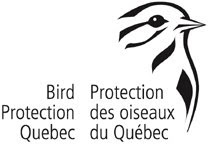Baie du Febvre
Cloudy skies, cool temperatures and steady winds from the NNW at 20km/h greeted 13 BPQ birders at Baie du Febvre this past Saturday. Conditions felt much colder than that description would indicate and I felt a little like "little Bo-Peep who lost her sheep" as the morning wore on and our numbers dropped off to two. But then we rounded up a few "strays" at lunchtime and 6 of us headed for the Parc Ecologique L'Anse au Port near Nicolet. Upon our arrival the number of snow geese was very low with probably only a few hundred visible in the field areas that were still flooded. They were outnumbered by the Canadas. But by about 10:00 a.m. flocks of snow geese started to appear from the southwest and continued to arrive in waves for the next hour or two. A conservative "guesstimate" of numbers would be in the 30 000 range but there may have been many more. (I would appreciate knowing if there was a more official count done that day by anyone associated with the Interpretive Centre at Baie du Febvre so that we could check our estimates). The birds seemed to settle in for the day and were only disturbed by the occasional bald eagle passing by. Other waterfowl were present in fairly large numbers but were spread out over the fields making counting extremely difficult. The numbers below are very conservative. The species which really stood out was pintail which seemed to be the most common duck present although green-winged teal may have been as numerous if less conspicuous. Surprisingly mallards seemed not to be that numerous with probably as many or more black ducks present. Pied-billed grebes made an impressive showing with at least a dozen being present in the various spots visited. Passerines numbers were very limited which may have something to do with the cold conditions. Snow buntings doing impressions of shorebirds around some muddy puddles were a nice surprise. Our extended trip to Parc Ecologique L'Anse au Port only produced a few new species but the boardwalk and tower would seem to have good potential for a little later in the spring season and tower offers a great view of Lac St Pierre and surroundings. Hawk watching on a suitable day?? Our complete list of 44 species is below but keep in mind that most estimates of numbers are on the low side. Snow Goose - 30 000+, Canada Goose - 2000+, Wood Duck - 4, Gadwall - 24, American Wigeon - 10, American Black Duck - 60+, Mallard - 50+, Northern Shoveler - 2, Northern Pintail - 600+, Green -winged Teal - 400+, Redhead - 2, Ring-necked Duck - 100+, Lesser Scaup - 20, Bufflehead - 12, Hooded merganser - 10, Common Merganser - 20, Ruddy Duck - 3, Pied-billed Grebe - 12, Turkey Vulture - 1, Bald Eagle - 3, Northern Harrier - 1, Red-tailed Hawk - 1, Rough-legged Hawk - 2, Killdeer - 6, Wilson's Snipe - 1, Ring-billed Gull - 80, Great Black-backed Gull - 6, Rock Pigeon - 12, Mourning Dove - 12, Downy Woodpecker - 1, Hairy Woodpecker -1, American Crow - 36, Horned Lark - 50, Tree swallow - 3, Brown Creeper - 2, American Robin - 6, European Starling - 100, American Tree Sparrow - 10, Chipping Sparrow - 1, Song Sparrow - 15, Snow Bunting - 120, Red-winged Blackbirds - 50, Common Grackle -50, Brown-headed Cowbird - 6
Oie des neiges - 30 000 +, Bernache du Canada - 2000 +, Canard branchu - 4, Canard chipeau - 24, Canard d'Amérique - 10, Canard noir - 60 +, Canard colvert - 50 +, Canard souchet - 2, Canard pilet - 600 +, Sarcelles d'hiver - 400 +, Fuligule à tête rouge - 2, Fuligule à collier - 100 +, Petit Fuligule - 20, Petit Garrot - 12, Harle couronné - 10, Grand Harle - 20, érismature rousse - 3, Grèbe à bec bigarré - 12 , Urubu à tête rouge - 1, Pygargue à tête blanche - 3, Busard Saint-Martin - 1, Buse à queue rousse - 1, Buse pattue - 2, Pluvier kildir - 6, Bécassine de Wilson - 1, Goéland à bec cerclé - 80, Goéland marin - 6, Pigeon biset - 12, Tourterelle triste - 12, Pic mineur - 1, Pic chevelu -1, Corneille d'Amérique - 36, Alouette hausse-col - 50, Hirondelle bicolore - 3, Grimpereau brun - 2, Merle d'Amérique - 6, Étourneau saisonnet- 100, Bruant Husonien - 10, Bruant familier - 1, Bruant chanteur - 15, Plectrophane des neiges - 120, Carouge à épaulettes - 50, Quiscale bronzé -50, Vacher à tête brune - 6
Thanks to everyone who came out and I hope all the"lost lambs" made it home safely. Wayne
Tuesday, April 10, 2012
Subscribe to:
Post Comments (Atom)





No comments:
Post a Comment